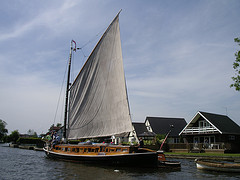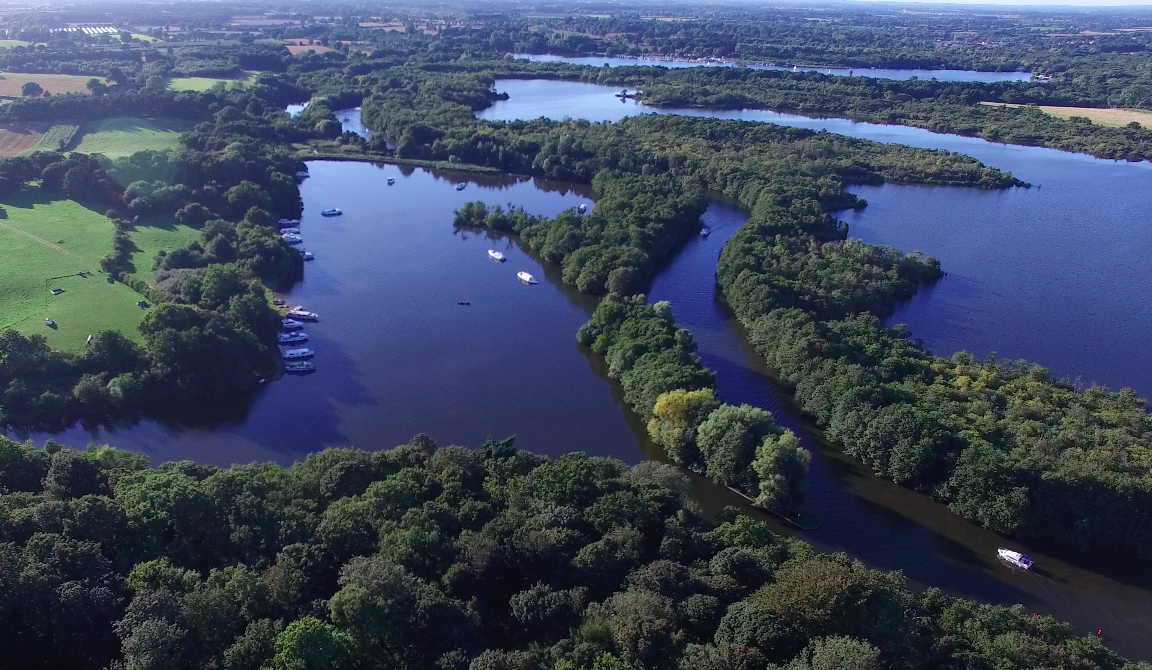|
Salhouse Broad
Salhouse Broad, one of the Norfolk Broads, is situated on the River Bure in The Broads in Norfolk, England Norfolk () is a ceremonial and non-metropolitan county in East Anglia in England. It borders Lincolnshire to the north-west, Cambridgeshire to the west and south-west, and Suffolk to the south. Its northern and eastern boundaries are the North .... The broad is situated just off the river and attracts little through traffic. It lies south of Hoveton Great Broad and approximately half a mile north of the village of Salhouse. Salhouse Broad is accessible from the landward side and moorings are also permitted to fee-paying boat visitors. It is privately owned and managed in conjunction with the community of Salhouse. The broad covers an area of and is home to many forms of wildlife including the Norfolk hawker dragonfly and the swallowtail butterfly. Black swans have been recorded on this broad. Salhouse Broad is unusual in being the result of the flooding of tenth c ... [...More Info...] [...Related Items...] OR: [Wikipedia] [Google] [Baidu] |
Norfolk, England
Norfolk () is a ceremonial and non-metropolitan county in East Anglia in England. It borders Lincolnshire to the north-west, Cambridgeshire to the west and south-west, and Suffolk to the south. Its northern and eastern boundaries are the North Sea, with The Wash to the north-west. The county town is the city of Norwich. With an area of and a population of 859,400, Norfolk is a largely rural county with a population density of 401 per square mile (155 per km2). Of the county's population, 40% live in four major built up areas: Norwich (213,000), Great Yarmouth (63,000), King's Lynn (46,000) and Thetford (25,000). The Broads is a network of rivers and lakes in the east of the county, extending south into Suffolk. The area is protected by the Broads Authority and has similar status to a national park. History The area that was to become Norfolk was settled in pre-Roman times, (there were Palaeolithic settlers as early as 950,000 years ago) with camps along the higher land in th ... [...More Info...] [...Related Items...] OR: [Wikipedia] [Google] [Baidu] |
River Bure
The River Bure is a river in the county of Norfolk, England, most of it in the Broads.Ordnance Survey (2005). ''OS Explorer Map OL40 - The Broads''. . The Bure rises near Melton Constable, upstream of Aylsham, which was the original head of navigation. Nowadays, the head of navigation is downstream at Coltishall Bridge. After Aylsham Lock and Burgh Bridge, the Bure passes through Buxton Lammas, Coltishall, Belaugh, Wroxham, Horning, past St. Benet's Abbey, through Oby, Acle, Stokesby, along the northern border of the Halvergate Marshes, through Runham and Great Yarmouth where it meets Breydon Water and flows into the sea at Gorleston. It has two major tributaries, the River Thurne and the River Ant. There is also Muck Fleet which connects the Trinity Broads (Ormesby, Rollesby and Filby Broad) to the main network. Other minor tributaries include the River Hor, which joins the Bure just upstream of Hoveton, The Mermaid which merges at Burgh-next-Aylsham and Scarrow Bec ... [...More Info...] [...Related Items...] OR: [Wikipedia] [Google] [Baidu] |
Norfolk Broads
Norfolk () is a ceremonial and non-metropolitan county in East Anglia in England. It borders Lincolnshire to the north-west, Cambridgeshire to the west and south-west, and Suffolk to the south. Its northern and eastern boundaries are the North Sea, with The Wash to the north-west. The county town is the city of Norwich. With an area of and a population of 859,400, Norfolk is a largely rural county with a population density of 401 per square mile (155 per km2). Of the county's population, 40% live in four major built up areas: Norwich (213,000), Great Yarmouth (63,000), King's Lynn (46,000) and Thetford (25,000). The Broads is a network of rivers and lakes in the east of the county, extending south into Suffolk. The area is protected by the Broads Authority and has similar status to a national park. History The area that was to become Norfolk was settled in pre-Roman times, (there were Palaeolithic settlers as early as 950,000 years ago) with camps along the higher land in th ... [...More Info...] [...Related Items...] OR: [Wikipedia] [Google] [Baidu] |
The Broads
The Broads (known for marketing purposes as The Broads National Park) is a network of mostly navigable rivers and lakes in the English counties of Norfolk and Suffolk. Although the terms "Norfolk Broads" and "Suffolk Broads" are correctly used to identify specific areas within the two counties respectively, the whole area is frequently referred to as the Norfolk Broads. The lakes, known as broads, were formed by the flooding of peat workings. The Broads, and some surrounding land, were constituted as a special area with a level of protection similar to a national park by the Norfolk and Suffolk Broads Act 1988. The Broads Authority, a special statutory authority responsible for managing the area, became operational in 1989. The area is , most of which is in Norfolk, with over of navigable waterways. There are seven rivers and 63 broads, mostly less than deep. Thirteen broads are generally open to navigation, with a further three having navigable channels. Some broads have ... [...More Info...] [...Related Items...] OR: [Wikipedia] [Google] [Baidu] |
Hoveton Great Broad
Hoveton Great Broad lies within The Broads in Norfolk, England, between Wroxham Broad and Salhouse Broad. The broad is connected to the River Bure, but not open to boat traffic. Hoveton Great Broad is part of an ancient navigation that has been deliberately allowed to become closed off to any public access since well before the last War. Recent changes in the official Ordnance Survey tide line mean that it is now tidal water and therefore closed illegally. A nature trail was laid out in 1968 - the first in the region. It is accessible only by boat. Mooring is allowed on the north bank of the Bure, opposite Salhouse Broad. Natural England has established a Nature trail. From the boardwalk, one can see the broad with its adjoining fens and alder Alders are trees comprising the genus ''Alnus'' in the birch family Betulaceae. The genus comprises about 35 species of monoecious trees and shrubs, a few reaching a large size, distributed throughout the north temperate zone w ... [...More Info...] [...Related Items...] OR: [Wikipedia] [Google] [Baidu] |
Salhouse
Salhouse is a village and civil parish in the Broads in the English county of Norfolk. It lies south of the River Bure and Salhouse Broad, about north-east of Norwich. The civil parish has an area of and in the 2001 census had a population of 1,462 in 604 households, increasing to 1,486 in 638 households at the 2011 Census. For the purposes of local government, the parish falls within the district of Broadland although areas adjoining the river and broad fall into the executive area of the Broads Authority. Churches Salhouse All Saints church, which is thatched and believed to date mainly from the 14th century (little remaining of an older chapel on the site), stands on a hill beside the Salhouse-Wroxham Road (B1140). The church contains among other features an oak rood screen, a unique sacring bell which hangs in the chancel and dates from the reign of Queen Mary, and two coffin lids discovered under the nave floor in 1839 and dated to the 13th century. There is also a ... [...More Info...] [...Related Items...] OR: [Wikipedia] [Google] [Baidu] |
Norfolk Hawker
''Aeshna isoceles'' is a small hawker dragonfly that is found in Europe, mostly around the Mediterranean, and the lowlands of North Africa. Its common name in English is green-eyed hawker. In Britain it is a rare and local species and is known as the Norfolk hawker. It has a brown colour with green eyes and clear wings and also a yellow triangular mark on the second abdominal segment which gave rise to its scientific name. It used to be in the genus '' Anaciaeschna'' as it has several differences from the other members of the genus ''Aeshna''. Its specific name is often spelt ''isosceles''. Identification ''A. isoceles'' is one of only two brown hawkers found in Europe, the other is '' A. grandis''. Both have a brown thorax and abdomen but ''A. isoceles'' has green eyes and clear wings and a diagnostic yellow triangular mark on the second abdominal segment. The hindwings have an amber patch at their base. In contrast ''A. grandis'' has yellowish wings and blueish eyes. The gre ... [...More Info...] [...Related Items...] OR: [Wikipedia] [Google] [Baidu] |
Swallowtail Butterfly
Swallowtail butterflies are large, colorful butterflies in the family Papilionidae, and include over 550 species. Though the majority are tropical, members of the family inhabit every continent except Antarctica. The family includes the largest butterflies in the world, the birdwing butterflies of the genus '' Ornithoptera''. Swallowtails have a number of distinctive features; for example, the papilionid caterpillar bears a repugnatorial organ called the osmeterium on its prothorax. The osmeterium normally remains hidden, but when threatened, the larva turns it outward through a transverse dorsal groove by inflating it with fluid. The forked appearance in some of the swallowtails' hindwings, which can be seen when the butterfly is resting with its wings spread, gave rise to the common name ''swallowtail''. As for its formal name, Linnaeus chose ''Papilio'' for the type genus, as ''papilio'' is Latin for "butterfly". For the specific epithets of the genus, Linnaeus applied ... [...More Info...] [...Related Items...] OR: [Wikipedia] [Google] [Baidu] |
Black Swan
The black swan (''Cygnus atratus'') is a large waterbird, a species of swan which breeds mainly in the southeast and southwest regions of Australia. Within Australia, the black swan is nomadic, with erratic migration patterns dependent upon climatic conditions. It is a large bird with mostly black plumage and a red bill. It is a monogamous breeder, with both partners sharing incubation and cygnet-rearing duties. The black swan was introduced to various countries as an ornamental bird in the 1800s, but has managed to escape and form stable populations. Described scientifically by English naturalist John Latham in 1790, the black swan was formerly placed into a monotypic genus, ''Chenopis''. Black swans can be found singly, or in loose companies numbering into the hundreds or even thousands. It is a popular bird in zoological gardens and bird collections, and escapees are sometimes seen outside their natural range. This bird is a regional symbol of both Western Australia, whe ... [...More Info...] [...Related Items...] OR: [Wikipedia] [Google] [Baidu] |





